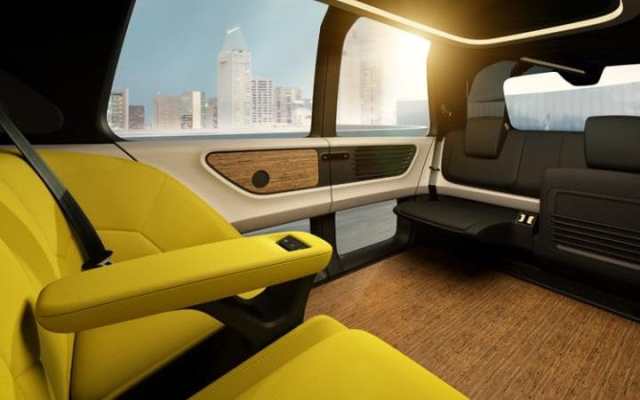Passing by the glittering luxury cars, with models draped elegantly over the hoods, you might get the impression that you were witnessing the height of power for the automotive industry. Not only has the internal combustion engine reached dizzying heights of refinement, but the plethora of electric, hybrid and fuel cell engines could leave you wondering if anything more need ever be invented.
Just take a look at Sedric, the transporter prototype from Volkswagen, the internals of which look more like an airport lounge than an SUV.
Designed from the ground up to be fully self-driving, it showed where VW thinks the future might head. You can summon your car via an app and tell it where you want to go. The car is supposed to be able to recognize its user and open the doors. You then chat nonchalantly to your passengers while the car whisks you to your location.
Volkswagen must — if you’ll forgive the pun — really motor. It has to spend billions on electric vehicles, self-driving and new mobility services, as it tries to accelerate away from the costly emissions test cheating scandal that hit demand for its diesel vehicles, and its overall brand position.
Meanwhile, over on the Porsche stand (also owned by VW), they plan to spend about $1.1 billion to create an all-electric Mission E, the brand’s first battery-only model that is expected to launch by 2020. Porsche also wants to make an all-electric version of its compact SUV Macan. And there will even be a hybrid version of the iconic 911 model.
Herbert Diess, the head of Volkswagen’s main passenger car division, told reporters: “We are really in a transitional phase for the industry. There are new competitors on the horizon like Tesla or Chinese ventures.”
Over at Volvo, they are adding new technology to their XC60 crossover, designed to help the car avoid or minimize damage in crashes. Its new ”Steer Assist” feature helps the SUV avoid hazards like other vehicles, pedestrians or large animals while also hitting the brakes at the same time.
Of course, the cost of this investment will change the structure of the car industry. BMW boss Harald Krueger said the cost of investments in new technologies could spur consolidation among smaller car makers. For example, some analysts say Fiat Chrysler Automobiles NV, which has less than 7 percent of the European market, could be a target for acquisition, given its high debts and expensive plants in Italy.
Car makers are scrambling to ape Tesla by introducing a range of new electric cars. Japanese brands like Toyota and Nissan have been the leaders in this field. Nissan launched its electric hatchback Leaf in 2010 and sold more than 250,000 units worldwide through December 2016, the largest number for a highway electric car in history.
Toyota’s hybrid vehicles sales in Europe were up 40 percent in 2016, and 32 percent of all sales in the region. So, today, one in every three cars Toyota sold in Europe is a hybrid.
Even Brexit is going to impact auto-maker strategy. British luxury brand Mini, which is owned by BMW, makes around 70 percent of its 360,000 cars at its Oxford plant in southern England, but now it looks like it will start making electric Minis outside of the U.K., probably in Germany or the Netherlands, or a new location altogether.
And Tata Motors-owned Jaguar is engineering its first electric performance SUV Concept — the I-Pace, with a view to giving it longer range, with fast charging times and better performance, aiming to beat out Tesla’s X model.
But while car markers scramble to add driverless functionality and electric versions, they are entirely missing three crucial strategic pressures.
The first is that just being electric and having driverless features is not going to be enough to save the car industry as it exists today. When every car is electric, no-one cares about the power train any more. When every car has driverless functions, you would not even think to buy a new car without those.
Secondly, a brand like Tesla’s most powerful weapon is, arguably, not the cars themselves but their customers. Tesla’s customers are literally willing the brand toward the future. That’s what they are buying when they buy a Tesla. In this respect Tesla is far closer to the brand of, say, Apple’s, than the brand of, say, BMW’s, which screams tradition, not innovation. Car makers don’t have an easy answer for that.
Lastly, it’s cities that are pivotal to the future of the car industry. This is where Europe could potentially punch above its weight. Regulation of transport infrastructure is going to be crucial for this new world, and the test of driverless technology in cities like Swindon in the U.K. will create a framework on which car markers can genuinely innovate. Until that happens, their plans for cars with different engines will come to nought. And let’s not even get into autonomous drone-like passenger vehicles flying above busy urban environments.
Beautiful cars at the Geneva Motor Show may be wonderful to look at. But 2017 just may go down in history as the last horse-drawn buggy “expo” did: a golden age that was soon overtaken by the future.
